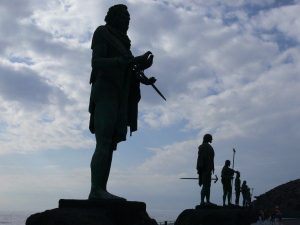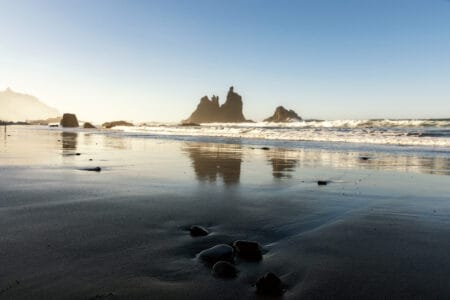 This beautiful island has seen its fair share of ups and downs throughout history. Formed by tremendous volcanic activity millions of years ago, Tenerife has had a rich past both naturally and culturally.
This beautiful island has seen its fair share of ups and downs throughout history. Formed by tremendous volcanic activity millions of years ago, Tenerife has had a rich past both naturally and culturally.
The earliest inhabitants were the ‘Guanches’ who were known for their bravery and strength. Fair and tall by appearance, they were not your average Spaniard by any measure and you can see their descendants display the same characteristic traits.
In fact, one theory states that the name itself is derived from ‘Tinerfe’, a famous Guanche mencey (monarch). He had nine sons who took part in a bitter power struggle after his death for control over the island. None emerged victorious and the whole place was divided in nine municipalities or ‘menceyatos’ and even today they form the basis of all the principal areas within Tenerife.
There is no concrete timeline which defines the arrival of the Guanches to this paradise. There is no evidence that links any sea route with their presence and neither did the surrounding island of La Gomera have any connection whatsoever with this mysterious island. Speculation is all that we have about these cave dwelling people who mummified their dead.
For many centuries, the whole island saw peace and the municipalities worked jointly to be efficient. But times change, whether for the good or the bad, and the 15th century saw the arrival of the Spanish who were ready to leave their mark on the history of Tenerife.
About 500 years ago, Alonso Fernández de Lugo, got permission from the Spanish royal crown to lead an expedition to the island and landed on its shores with 2000 men and over 200 horse riders. Initially, they had easy successes as the coastal areas fell under the might and technology of the invading army. Some of the municipalities adopted a process of peace that allowed the Spanish to conquer without conquest. But 5 municipalities namely Tacoronte, Daute, Icoden, Tegueste and Taoro took the path of war and shouldered arms against the mercenaries. This delayed the Spanish triumph by over two years but finally all the menceyatos fell and Spanish hold on the island was complete by 1496.
Slavery and forced labor became the order of the day and inhabitants were prone to disease and hunger. This went on for years but was kept extremely secretive and until very recently, the Spanish government denied any knowledge of brutality. But slowly, the curtains are lifting and Guanche names and traditions are re-emerging throughout the island. In Candelaria, statues made of lava exist to keep alive the memory of the nine great kings at the beach near the basilica.
The Spanish victory resulted in the forming the city of San Cristobal de La Laguna in 1496. But this city remained closed to foreigners and held its secrets for a very long time. This was very strange for a city that had no real walls! But recently, it has woken up from its slumber and opened its doors for everyone who wishes to know about this turbulent period in Tenerife’s history.
In 1890, it was discovered as an ideal tourist destination and people forgot the real history behind the cities and their architecture. A museum to commemorate the history of Tenerife has opened up to rectify this anomaly, which gives visitors valuable insight about the past of this amazing place and the making of the island of Eternal Spring.






2 Comments
I worked as a holiday rep for ILG travel group on Tenerife during 1985 and 1986 and would love to know if there are any old photographs of Tenerife resorts- Puerto de la Cruz, Los Christianos, Las America’s I also remember visiting regularly Los Abrigos, Candelaria. We also loved to go into the hills in the south of Tenerife for rustic meals. Happy time’s. I’m not sure if I dreamt this but was there ever a sign similar to the Hollywood sign on the hills above los christianos and Las America’s Thanks
If you’re on Facebook, take a look at this page:
https://www.facebook.com/groups/FotosAntiguasTenerife/